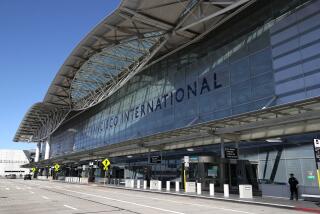Soviet Troops Evict Protesters in Armenia : 36 Injured in Clash at Yerevan Airport; General Strike Called
- Share via
MOSCOW — Troops supported by armored cars evicted an estimated 3,000 demonstrators who had closed Yerevan airport in the southern Soviet Republic of Armenia in a sharp escalation of the civil strife in the region, Soviet officials said Wednesday.
At least 36 people, including several policemen, were injured in the airport melee late Tuesday, officials said, and the clash triggered a general strike that paralyzed Yerevan itself Wednesday.
Thousands of armed troops were reported to be patrolling the main streets of Yerevan and neighboring towns Wednesday evening in a major show of strength by the government, which appears determined to end the months of unrest in Armenia and neighboring Azerbaijan. Opera Square in Yerevan, the focus of demonstrations in the past, was ringed by troops and closed to the public.
“Tensions are very, very high,” a university professor in Yerevan said by telephone Wednesday evening. “People are angrier now than anytime in the past five months. There could be real violence. The troops could make it worse, because people might attack them and they would defend themselves. . . . The situation is volatile, even explosive.”
Most factories, offices and shops, except for food stores and medical facilities, were closed Wednesday, according to Armenian journalists. Crowds estimated at hundreds of thousands crowded the streets around Opera Square and near the main government and party offices.
“We have a general strike that is growing by the hour,” an editor at the Russian-language paper Kommunist said by telephone Wednesday afternoon. “People do not seem to be in a mood to be bought off or fobbed off.”
The latest demonstrations in Yerevan apparently stemmed from deepening dissatisfaction there with the central government’s delay in resolving the future of Nagorno-Karabakh, a predominantly Armenian enclave in Azerbaijan that wants to be transferred to Armenian administration. Azerbaijan has refused to cede the territory, which has a population of about 184,000.
Armenians had hoped that the special Communist Party conference held here last week would settle the conflict. But the party leadership deferred all ethnic questions until the policy-making Central Committee can discuss the whole issue at a plenary session, which will probably not be convened until a new policy on nationality issues has been worked out.
The resulting protest and counter-protests have left 35 people dead, according to official figures. Estimates from Armenian nationalists and dissident sources here are nearly twice that figure.
Armenian nationalists claimed that the troops, drawn from special internal security forces outside the region, had fired upon the crowd at the airport, killing as many as five people. Several people also were reported by these sources to have been crushed beneath the wheels of armored cars. Dissidents put the number of injured at more than 70.
But Vadim Perfilyev, a government spokesman here, firmly denied that there had been any deaths resulting from the airport clash, although he acknowledged it was one of the worst in recent weeks.
Western newsmen have been barred from both Armenia and Azerbaijan because of the unrest, but this account is pieced together from both official and dissident sources:
The protest at Yerevan’s Zvartnots Airport grew out of a mass rally at Opera Square on Monday, according to official sources here and in Yerevan, when Armenian nationalists urged participants to march on the airport and close it to demonstrate their intention to end central government control of the region by taking power into their own hands.
Thousands of protesters reached the airport, most of them on foot, according to the central television news program Vreyma. About 400 took over the airport terminal, and the rest swept onto parking areas and taxiways used by airplanes.
They allowed planes to land, Vreyma said, but refused to permit more than 60 flights to board their passengers, estimated at 14,000, or to take off, according to Soviet officials.
Club-wielding police backed by the troops eventually cleared the terminal and then moved the protesters from other parts back to the airport, from which dozens were sent home, according to Soviet accounts of the action.
More to Read
Sign up for Essential California
The most important California stories and recommendations in your inbox every morning.
You may occasionally receive promotional content from the Los Angeles Times.










